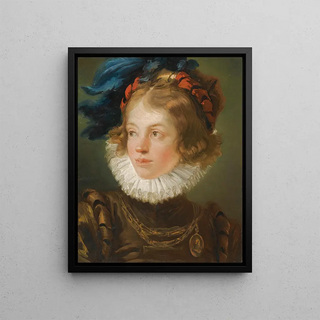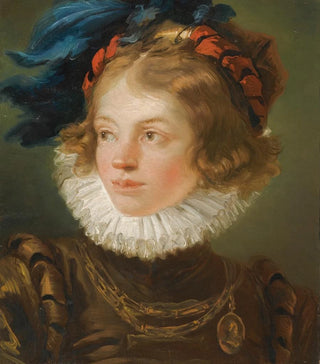Art print | A young boy in page costume - Giovanni Battista Tiepolo


View from behind

Frame (optional)
The artwork "A Young Boy in Page Costume," created by Giovanni Battista Tiepolo, is part of the rich tradition of 18th-century Venetian painting. This delicate depiction of a young boy dressed in a page costume evokes an atmosphere of refinement and elegance. The viewer is immediately drawn to the child's sparkling gaze, which seems to capture a moment of life while being immersed in a universe of light and color. Tiepolo, an undisputed master of chiaroscuro, manages to infuse his characters with an almost lifelike dimension, giving them a palpable presence. This piece, with its charm and finesse, invites prolonged contemplation, allowing one to explore the subtleties of human expression.
Style and uniqueness of the work
Tiepolo's style is distinguished by its ability to blend lightness and depth. In "A Young Boy in Page Costume," pastel colors and play of light create an airy atmosphere, while the carefully balanced composition highlights the grace of the subject. The artist uses delicate brushstrokes to render the texture of the clothing, thus accentuating the contrast between the shimmering fabric of the costume and the softness of the child's skin. This work stands out for its capacity to evoke emotions through meticulous details, such as the boy's discreet smile and the sparkle in his eyes. Tiepolo, a true virtuoso, succeeds in capturing innocence and childhood curiosity, while incorporating elements of the aristocratic culture of his time.
The artist and his influence
Giovanni Battista Tiepolo, born in 1696 in Venice, is one of the most influential artists of his era. His career spanned several decades, during which he established himself as the court painter par excellence. Tiepolo worked for nobles and religious institutions, creating monumental frescoes that testify to his exceptional talent. His influence extends beyond Italian borders, inspiring many European artists, notably in France and Spain. The lightness of his style, as well as his mastery of visual storytelling,

Matte finish

View from behind

Frame (optional)
The artwork "A Young Boy in Page Costume," created by Giovanni Battista Tiepolo, is part of the rich tradition of 18th-century Venetian painting. This delicate depiction of a young boy dressed in a page costume evokes an atmosphere of refinement and elegance. The viewer is immediately drawn to the child's sparkling gaze, which seems to capture a moment of life while being immersed in a universe of light and color. Tiepolo, an undisputed master of chiaroscuro, manages to infuse his characters with an almost lifelike dimension, giving them a palpable presence. This piece, with its charm and finesse, invites prolonged contemplation, allowing one to explore the subtleties of human expression.
Style and uniqueness of the work
Tiepolo's style is distinguished by its ability to blend lightness and depth. In "A Young Boy in Page Costume," pastel colors and play of light create an airy atmosphere, while the carefully balanced composition highlights the grace of the subject. The artist uses delicate brushstrokes to render the texture of the clothing, thus accentuating the contrast between the shimmering fabric of the costume and the softness of the child's skin. This work stands out for its capacity to evoke emotions through meticulous details, such as the boy's discreet smile and the sparkle in his eyes. Tiepolo, a true virtuoso, succeeds in capturing innocence and childhood curiosity, while incorporating elements of the aristocratic culture of his time.
The artist and his influence
Giovanni Battista Tiepolo, born in 1696 in Venice, is one of the most influential artists of his era. His career spanned several decades, during which he established himself as the court painter par excellence. Tiepolo worked for nobles and religious institutions, creating monumental frescoes that testify to his exceptional talent. His influence extends beyond Italian borders, inspiring many European artists, notably in France and Spain. The lightness of his style, as well as his mastery of visual storytelling,






